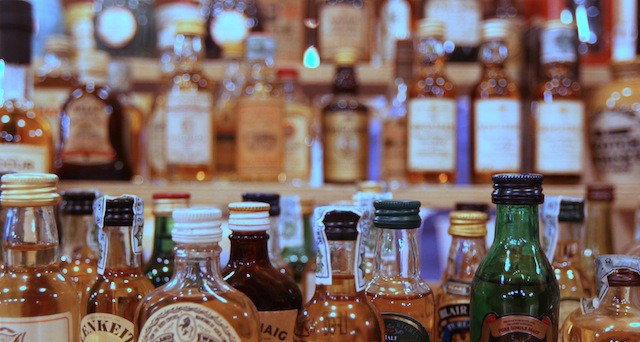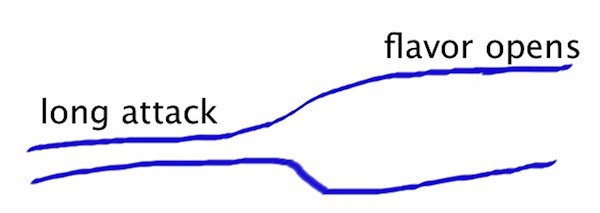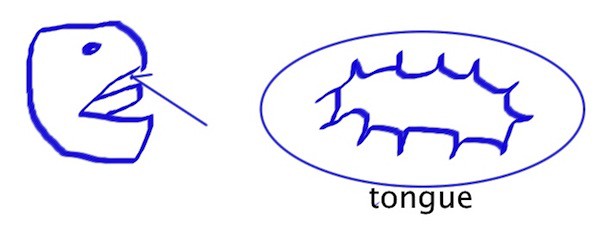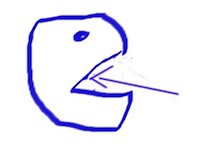Drinking Up and Sitting Down With the Men’s Men at the Nashville Whiskey Festival
by Lauren C. Ostberg

This is the first installment in a series about women and whiskey.
As soon as I enter the Nashville Whiskey Festival, I start looking for a way out. I’m already dehydrated and surly — my walk here ended up taking a half hour longer than I thought it would, and involved clambering under a highway, over train tracks, and through a neighborhood of barbed wire fences and flickering-light warehouses. All I want to do is sit down, chug some water, and plan out my next 10 drinks.
Instead, I enter a loud, narrow room, lined with tables on the perimeter. I find a palette of bottled water and snag one — they’re tucked off to the side, at least 10 feet from the complimentary food, so I worry that they’re VIP-only, or part of some fancy whiskey-taking ritual I’m not cultured enough to understand. There are only two seats in the whole place, sort of Adirondack display chairs, right in the center of the room. I think they might be display-only, or VIP only, so I wait until Chair Guy, a bearded man who appears to hold court there, turns his back. I sit, and feel guilty. I resent the VIP system for simultaneously offering, and then leaving undefined, certain privileges.
Later, when I walk by and hear Chair Guy loudly offer a VIPed old man a seat, I assume that he is saying this partly in sarcasm, for my benefit. He is reinforcing what I already feel: what am I even doing here?
Sample No. 1: Jameson Redbreast (Cork, Ireland)
This whiskey had a long attack and a velvet tongue that thickened mine — a VIP selection, according to my program.

It was, I thought, a little too sophisticated for me. I favor the original Jameson, which dances on the tongue before it scorches the mouth.
Like this:

Jameson was my first real drink. I didn’t really drink in the States — I was afraid to break the law, and very into the “authenticity” of unlubricated, usually uncomfortable, social interactions — but when I was 20, I studied abroad in Ireland, where the drinking age was lower. And while I considered myself superior to chugging Natty Light in frat halls, I figured alcohol had a culture, some social cache. I wanted to be a girl who knew how to be in a bar.
A friend who’d joined me at the Irish pub asked how I liked the whiskey. “Tastes like poison,” I said, and I smiled, because, while I wasn’t averse to self-destructive behavior, I was averse to deluding (diluting?) oneself about it. I liked an honest liquor, a scourge.
Sample No. 2: Laphroaig Triple Wood (Port Ellen, Islay, Scotland)
The woman who pours my whiskey is tall, which helps me take her seriously, despite her perky demeanor and conventional attractiveness. She encourages me to come back and try the 25 year (according to the program, also a VIP selection). And, though I briefly bristle over the possibility that she’s critiquing my selection, she seems so sincere about it that I instead assure her I’ll come back and smile at her, the same way I would if I were price-shopping at the farmer’s market.

This whiskey is incredible. Three woods? I taste oak, see chestnut. There’s a little peatiness here, and something about the texture that reminds me of a birch tree — layers that are solid but chewy, the kind of texture you’d get with the flesh of an apple, a sourdough crust, and some phyllo dough. “I want to eat every plant,” I jot in my tasting notes, and I picture myself rolling, mouth-open, through lilacs, incising some lovage, gnawing off a tree knot.
Sample No. 3: Parker’s Reserve (Heaven’s Hills Distillery, Bardstown, Kentucky)
Two experienced festival goers advise me to try to Parker’s Reserve, even though I tell them I’m not into bourbon — “too sweet,” I claim. I tell them I think some of this whiskey is too sophisticated for me, that I like alcohol that tastes like alcohol. I want a drink that’s a little elemental, raw, one that hasn’t lost its edge to age. It’s an obvious humble brag, even if it’s honest, and I’m really trying to claim, by taste, that I’m the elemental, raw one.
They nod and give me a few notes on 150-proof bottles that I should save to the end, after my tastebuds are already blown out, that I’m told “will burn your FACE off.”

They were right about the Parker’s. It’s delicious, kind of spiky and bright, sharp but not abrasive, with a lemony flavor. I can feel it on the roof of my mouth first, and then my tongue. It moves in a carousel motion, with little slow-release explosions — less like Pop Rocks, more like the feeling you know if you’ve ever chewed cardamom: little flickers of heat that remind you sensations exists there, too, but, at the same time, leaves you a little pockmarked or numb.
Sample No. 4: Jim Beam, Booker’s

The pourer rinses out my glass by pouring some water into it, swishing it around, and dumping it into the bucket at the middle of the table — embarrassing, I think, just the way it’s embarrassing when someone pouring coffee rinses your travel mug out first, because then you know that what you consider acceptable someone else considers unclean. He’s polite about it, though — his body language says, oh, you obviously assumed I’d clean then pour, which is what I’m here for, anyway — which takes some of the sting out, until I remember that politeness is probably just an affirmative defense to class-based disgust.
The whiskey hits me in the back of the throat, but it has no tongue activity worth diagramming, and, despite its proximity to my sinuses, I can’t feel it in my nose. I want a whiskey I can breathe in. I book it out of there, a little tipsy, and start humming Radiohead’s “Creep.”
Sample No. 5: Corsair Quinoa, Corsair Artisan Distillery (Nashville, TN)
I cave into marketing here, and give in to the potent combination of ancient grain and the word “artisan.” The woman pouring seems to be Corsair’s backroom distiller, and she’s flustered by a local news personality who is trying to interview her.
I was originally torn in choosing between Rasputin and Ryemageddon, but I don’t want to interrupt the interview, so I just say, “me too!” while she’s pouring another guy the Quinoa. The guy is 40, maybe, and he takes a sniff and then dumps it out in the center bucket. Rude, I think, but he also doesn’t look like he’s in their target demographic.
I hear Distiller Woman (who I feel an alliance with, now that she’s making eye contact with me to avoid looking at the reporter) tell the journalists that they just experiment with whatever grain seems possible. I approve of experiments. I drink my whole sample, even though it’s tepidly flavored, and certainly not a complete protein.
Sample No. 6: Cabin Fever Maple Flavored Whiskey (Portland, MD)
The guy pouring the whiskey is alone at the table, and he’s middle aged, a little overweight, and bearded — exactly the demographic around whom I feel most at ease. He tells me that he and his brother started distilling several years ago, as a small-time enterprise between New Hampshire and Vermont, and my pro-Vermont bias (cultivated by my college roommate, who’d grown up there) overshadows my anti-sweet bias. I’ll try it — the guys at the food table said it was “like syrup, ‘cept not sweet!” but I’m reasonably skeptical.

Whelp. It’s syrupy, not sweet. It’s a little thinner than I’d expect either whiskey or syrup to be — unless it’s from a fresh-tapped tree — but its vaguely woodsy, nature’s plasma transfusion. No burn, smooth finish.
Sample No. 7: Corsair Triple Smoke, Corsair Artisan Distillery (Nashville, TN)
Distiller Woman (see Sample No. 5) continues to delight me conceptually — this whiskey, she said, pulls in smoke without taking the traditional peat route — but what I taste is, again, tepid, low amplitude, and with a subtle smoky flavor that dissipates, rather than swelling through, my mouth. She’s right — it’s very different from peat smoke. But I love peat.

Sample No. 8: Bowmore Legend (Loch Indall, Islay, Scotland)
Oh, my. Bowmore. On a trip celebrating our graduation from college, my friend Aerin and I did a whiskey flight in Scotland, and I tried some Bowmore’s Darkest. It was so richly, unapologetically peaty that I brought a bottle back home, despite my strict budget, and realized, for the first time, that liquor could bottle something elemental and ephemeral. My love of whiskey, initially 70 percent affectation, was slowly becoming sincere.
It was around the same time — deluded by my chances for future employment, and still feeling competitive with an ex who listed “beverages” as a Facebook interest — that I first contemplated becoming a whiskey snob. It was calculatedly quirky, with barely disguised upwardly-mobile aspirations. And, best of all, it was an entree into a man’s club, full of men’s men. I love the trappings of man’s clubs — cigar bars, leather chairs, antler decorations — and I’m interested in power, in the chest-thumping, unfettered ambition that society still calls “masculine.” I’m also all about women entering these territories and claiming them, swagger and all, for ourselves. So, at 22, after Scotland, I pictured whiskey snobs as a group of old, bearded men that met around a rustic round table to talk Scotch. I decided that I wanted to get to that table by the time I was 30, to rub leather elbow pads with these guys, in some alcoholic embodiment of Feminist Manifest Destiny.

Twenty-eight now, and drinking Bowmore (12, not Darkest — it’s not in stock) for the first time in six years, I bliss out. My notes say, “fills mouth with quiet vapor, then dissipates.” The diagram note says, “rhythmic wisps.” There’s a harp playing the chords to “Time After Time” in the background and I’m getting misty.
Sample No. 9: Campfire (High West Distillery, Park City, UT)
I strike up a conversation with the second pourer at the Bowmore table. She’s a student at Vanderbilt’s business school, and is apparently more financially shrewd than I am, because she’s gotten to the festival for free. Later on in the night, she’ll pour me more samples and share her (comparably vast) knowledge of bourbon. I will smuggle her boyfriend small batch Four Roses and drink the moonshine he’s dispensing; I will announce, repeatedly, “Every time you speak a sentence, I love you more.”
For now, though, I’m just asking her to recommend some whiskeys, and recounting what I think is a story about Chair Guy’s passive-aggressive confrontation, the loud “Why don’t you sit here?” after I’d already sat there. I point him out: “That guy — good-looking, right, but like he knows it. So, annoying.” I feel an increasing need to confront him, and I’m trying to figure out if that’s a rational, empowered act, or just aggressive-aggressive, whiskey-drunk behavior.
I move onto the next drink, hoping that something like a “campfire” will keep up the smoky spirit but kumbayah me out a little. The campfire whiskey is soothing. A light amber color, it warms my mouth — mostly the top front — without burning anything. The flavor is lightly smoky; subtle, ephemeral. Embers ideal for slow-roasting a marshmallow.
Instead of drawing a diagram of the whiskey, I draw a detailed diagram of a wooden object I’ve seen Chair Man move around the chair area. Here:

Sample No. 11-?:
I made a terrible mistake. I misread my cell phone clock (or rather, read it correctly — my phone still thinks I’m on Eastern Standard Time, even though I switched time zones) and calculated that whiskey fest would end in 15 minutes. So I started sampling indiscriminately. I tried three moonshines (“Foul!” I announced — the cayenne pepper and cinnamon had the wrong kind of burn) and, according to my records, at least three VIP selections. I have records because I started commissioning strangers (one an actual “squire”) to transcribe my whiskey notes. One reads, “Badass.” Another: “150 proof. $275 dollar bottle.”
I tried them all, and, over the next hour, got garrulous, friendly-drunk. I tried the Laphroaig 25 year that the tall, conventionally attractive woman suggested, and then I asked her if her gorgeousness was an employment requirement. (Note: she is actually a nurse. Brand repping is her side job.) I surrendered all pretension of superior taste and asked pourers to give me a sample of their favorite. I stopped hating the noise, the crowd, even the VIPs. I joined them.
And then I talked to Chair Guy. He didn’t know what I was talking about, and when I clarified, he said, no, he wanted people to sit in the chairs. He was selling them. The thing he was carrying around (see Sample No. 9) was actually a swing.
The last whiskey I tasted, or meant to taste, was a Japanese blend — the Suntory Yamazaki 12 year, I think — that Business School Ellen recommended. She tried to persuade me Japanese whiskeys (which I’d pooh-pooed before, figuring I’m all about the earthy burn of old-school stuff) were up-and-coming, that, in recent taste-tests, they’d out-scotched the Scottish.
Blaspheme, maybe, to the Keepers of the Quaich — a close approximation of my castle-meeting club for men’s men — but I’m not a member there. Instead I had Ellen, a founding member of her local Bourbon Society. She told me that Japanese whiskey is smooth, and when I whined about this (for “smooth,” in whiskey speak, means weak, subtle, oversweet), she insisted that the drink’s power comes from warmth, not abrasiveness, that it blends the peaty notes of single malt scotch in an entirely novel environment.
Ellen took over my tasting notes and wrote “The future!” beside Table 32’s Hibiki, Hakushu, and Suntony selections.
I took a taste. My buds were already blown out, but I bet it was sensational.
Top photo via br1dotcom/flickr.
Lauren C. Ostberg is a beard enthusiast, a nonfiction writer, and a law student. She still swears by Jameson.